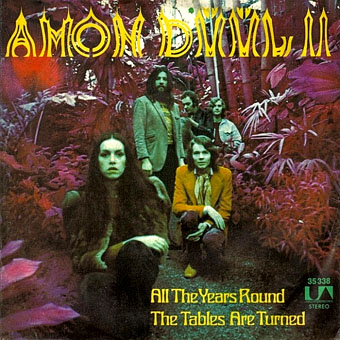
All The Years Round (7-inch single, 1972).
I mentioned earlier that Falk-Ulrich Rogner’s cover art for Amon Düül II was worthy of a post so here you are. Amon Düül II were slightly ahead of the pack in the German music scene of the 1970s, starting earlier and (arguably) finishing their prime period earlier. They were also closer in musical style and group ethos to the psychedelic/early prog groups in Britain and America, especially Hawkwind with whom they shared a record label and a bass player. Other German groups were often psychedelic to some degree but Amon Düül II went all-out for a German take on psych rock, with extended guitar-heavy jams played against oil-on-water projections.
Falk-Ulrich Rogner was one of the longer lasting members of the group’s shifting personnel, playing organ and electronics, writing lyrics and creating artwork that’s a perfect match for what I always think of as Amon Düül II’s Gothic Surrealism: a blend of lyrics and themes running through songs titled like Max Ernst paintings: Flesh-Coloured Anti-Aircraft Alarm, Archangel’s Thunderbird, Stumbling Over Melted Moonlight, Green Bubble Raincoated Man. The cover art is generally a collage of photographs, old paintings and other graphics, a familiar technique for psychedelic album covers. What gives Rogner’s work an edge is the way he blends multiple collages together by either photographic exposure or the photographing of projected transparencies. This has the effect of softening hard edges and transitions, and makes the resulting images all the more hallucinatory and dream-like. Effects like this are easy to achieve today with Photoshop but in the early 1970s they required a considerable effort.

Phallus Dei (1969).
At first glance the cover of the gloriously titled debut album looks like a painting but it’s a photograph of a tree silhouette juxtaposed against some vague collage business. This doesn’t really communicate the lysergic intensity of the music within which may explain why the cover was changed to something more typically psychedelic for its UK release.
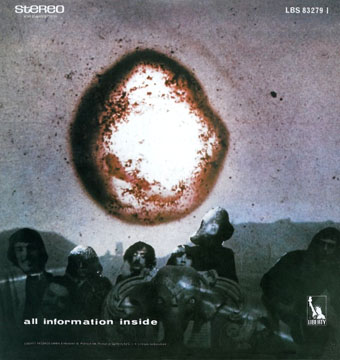
The back cover inaugurates a pattern of placing the band on the back of the album, a reversal of the usual state of affairs even today.
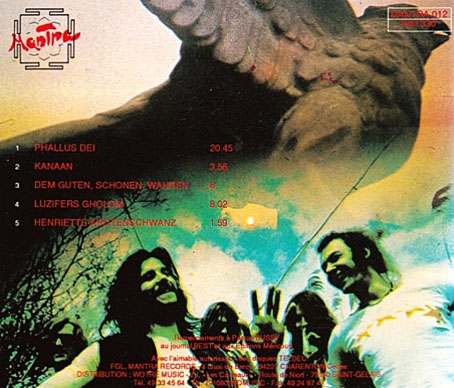
The first CD release of Phallus Dei on the Mantra label featured what may be another Rogner photomontage, one that I’ve not seen anywhere else.
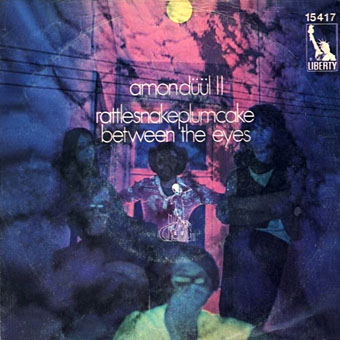
Rattlesnakeplumcake (7-inch single, 1970).

Yeti (1970).
One of my nominees for greatest rock albums of all time, and a strange cover. Why a reaper? What’s that pink triangle about? (And why Yeti, for that matter?) The irresolvable mysteries in the Düül discography are what keep me coming back for more.
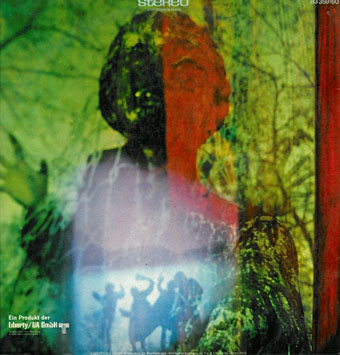
Yeti was a double album so Rogner filled out the interior with a planetoid collage. The skull-faced figure wearing a hat in one of the temple windows appears on the back of the next album. When I needed a title for my essay about psychedelic collage artist Wilfried Sätty (who was German, as it happens), I borrowed the title of the final song on this album, Sandoz In The Rain.
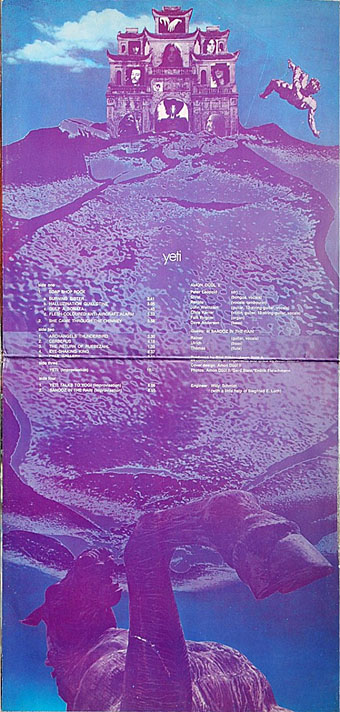
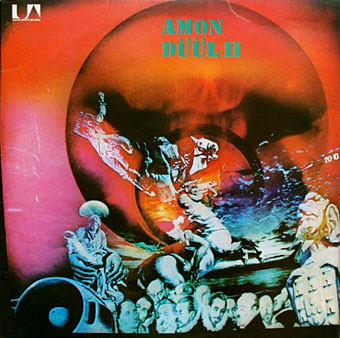
Dance Of The Lemmings (1971).
Another double album which doesn’t sustain itself over its running time as well as the previous masterwork but which also didn’t deserve to be dismissed by Julian Cope in his Krautrocksampler book. The main problem with the first half of the album, as my friend Nick often used to note, is that the bass is too high in the mix while the drums—so prominent on Yeti—have been buried.
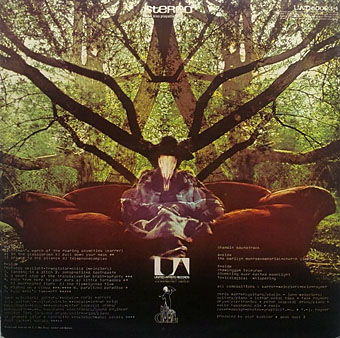
The group had reached a peak of psychedelic Surrealism by this point, and Rogner’s artwork is the ideal illustration. The skull-faced figure sitting on a couch in a forest is deliriously bizarre; opening the sleeve you find yourself at the controls of a Düül spacecraft with the band members (and the reaper from the cover of Yeti) visible in the instrument panels. Closer scrutiny of the controls reveals a picture of the Tower of Babel, and a switch with two settings: “Off” and “Trip”.
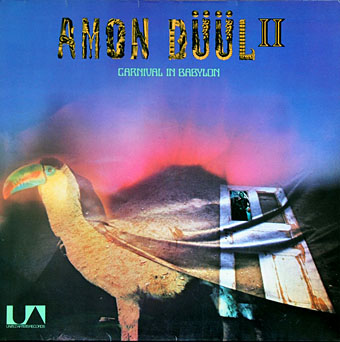
Carnival In Babylon (1972).
After those pyrotechnics this cover is a disappointment although Rogner still managed to blend a toucan and what may be a llama. The gatefold sleeve shows an infra-red hothouse group shot.
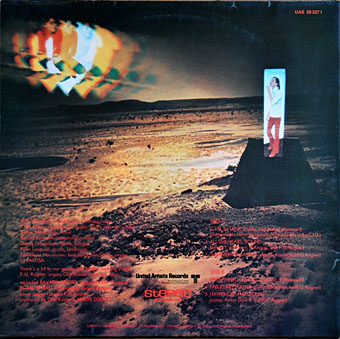
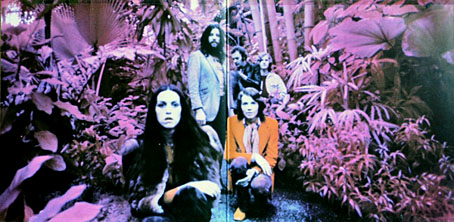
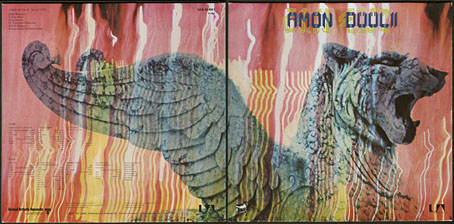
Wolf City (1972).
This cover has already been the subject of a post of its own. A boy at my school who claimed to know about these things declared that the gatefold interior is “what it looks like when you’re tripping”, something I still think of every time I look at this picture.
Rogner also worked on the sleeve for Viva La Trance, the album following Wolf City, but that’s where I mark the end of the prime Düül. On Viva La Trance they abandoned the Surrealism for politics and love songs, and in so doing lost their originality. The Utopia album below is an odd companion album to Wolf City with another Rogner sleeve and many of the same musicians. Musically the album is like Wolf City but with a jazzier feel; there’s also a different version of Deutsch Nepal.

Utopia (1973) by Utopia.

In 1992 the BBC released this recording of a Düül concert from 1973, and in doing so they found another Rogner montage to use for the cover. The concert is Viva La Trance era but contains some earlier songs and is very well-recorded. It’s a shame the superior Live In London album doesn’t sound this good but the BBC set is still worth seeking out.
Elsewhere on { feuilleton }
• The album covers archive
Previously on { feuilleton }
• The sphinx of Wolf City

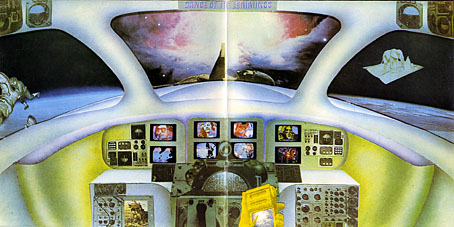
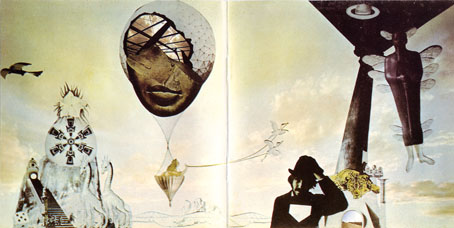
Ah–WOLF CITY! Had not read the in-depth identification of the Brunswick Monument chimera either before. Much thanks…
I’m still a little surprised by the Wolf City discovery. I guessed it might get solved eventually but didn’t anticipate it happening by such a circuitous route.
Incidentally, the Riding On A Cloud section of Dance Of The Lemmings features what I always think of as a Lovecraftian moment: “Sunk cities are rising from the sea”.